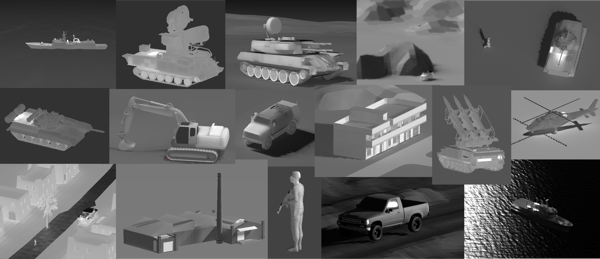Many companies involved in either target detection or design of vehicles, uniforms, and equipment are often at a loss for how to deal with infrared simulation. In many cases they would have the capacity to simulate infrared if they were able to get an initial model setup as a baseline, along with expert guidance.
Custom infrared signature models are available from ThermoAnalytics through our Model Library and our custom model development services. To gain the many benefits of simulation, a model needs to include relevant details to yield accurate results. ThermoAnalytics’ services include providing the client with target geometry, heat sources like electronics, human metabolism, engines and motors, paints and surface conditions, and the background around the target. We leverage our 20+ years of experience computing (first principles) signatures and use our industry-leading MuSES software to generate renderings of ground, sea, or air. Because every project is different, we take an adaptive approach to the infrared analysis services we offer. Below we outline the general approaches we take to provide clients with accurate models.
Providing Infrared Models from our IR Model Library
ThermoAnalytics has an extensive model library of humans, buildings, vehicles, ships, terrains, and aircrafts. Because the geometry and construction for these models is complete, our clients can begin performing analysis much faster. These models have been checked for accuracy and proper thermal response, ensuring results that can be relied on and modified as needed by our clients.
 Examples from the ThermoAnalytics model library
Examples from the ThermoAnalytics model libraryCustomized Versions of Our Library Models
Often clients have specific requirements that require modifications to standard models from our database. For example, we have several versions of a T-72 tank model but a client may need a specific mission profile or engine operating condition. Our team can rapidly deliver a customized version of the model, either for analysis by our client or as a full simulation with interpreted results, as detailed below.
Developing New Models
Beyond basic customization, our engineers can develop models from scratch. Starting either with CAD exports or photographs, we create appropriately-resolved mesh geometry and supply complete boundary conditions, heat sources, and surface conditions. When inputs are not immediately available, our team can provide estimates based on their experience or assist with field tests or laboratory measurements.
Developing Infrared Target Models
Accurate models of ground vehicles, ships, planes, people, and terrains are needed to predict target contrast and detection range under specific operational and mission profiles. Our MuSES software remains the global leader in computing the relevant renderings and our engineering services team is unquestionably the most experienced group of experts in best practices and modeling methods.
Infrared Contrast Assessment
Complex vehicles and systems require comprehensive engineering analysis. Our team of engineers has simulated the most advanced systems available and is well-versed in methods of computing and evaluating contrast. We can assist with any type of target, and support your simulation of glints, exhaust plumes, or other complex modeling challenges. Because we develop the prediction code as well as the workflow, we ensure that the physics we need are represented. We can also include the impact of global location and weather in target contrast analysis.
Infrared Signature Reduction
Once the baseline performance of a system has been established, various methods can be employed to manage IR signature. For search and rescue missions, the highest possible contrast is desired; with stealth technologies, the minimal contrast is desired. Because we offer thermal simulation services for a wide range of purposes, our extensive experience is available for our clients’ benefit. From heat shield design to paint optimization and camouflage analysis, our team can provide the design and the analysis to support your goals. 
Advanced IR Research and Simulation
Not only can we impose variation on the ‘system’ in question, but we can also hold the target constant and optimize the selection of wave band for detecting an object under circumstances of interest. For example, we have supported the US Coast Guard in evaluating search and rescue aids for detecting man-overboard victims at various ranges and weather conditions. These studies can be used to develop automatic target detection algorithms. We can also perform hyperspectral analysis, enabling highly specialized detection methodologies for search and rescue missions.
Infrared Scene Generation
Simulating a modeled scene as perceived by an aerial sensor is another advanced technology that we support. Whether the target is stationary or moving, we can provide at-range, atmospherically attenuated views including sensor response, blur and noise. The output can be still images or an animation.
IR Simulation Results Interpretation
Once IR data sets are validated and verified, there remains the art of interpreting that data and generating valuable insight for engineering and research teams. A simulation can be thought of as an experiment; because sensitivity analysis and other complex trade studies can be performed, integrating the output of the models into a clear set of conclusions is the final step.
We encourage you to contact our engineers for a discussion of your needs, and we look forward to partnering with you to develop an approach that is both valuable and cost-effective.

